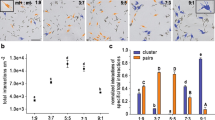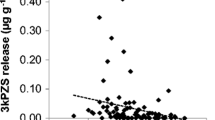Abstract
Diatoms are species-rich microalgae that often have a unique life cycle with vegetative cell size reduction followed by size restoration through sexual reproduction of two mating types (MT+ and MT−). In the marine benthic diatom Seminavis robusta, mate-finding is mediated by an l-proline-derived diketopiperazine, a pheromone produced by the attracting mating type (MT−). Here, we investigate the movement patterns of cells of the opposite mating type (MT+) exposed to a pheromone gradient, using video monitoring and statistical modeling. We report that cells of the migrating mating type (MT+) respond to pheromone gradients by simultaneous chemotaxis and chemokinesis. Changes in movement behavior enable MT+ cells to locate the direction of the pheromone source and to maximize their encounter rate towards it.






Similar content being viewed by others
References
Field CB, Behrenfeld MJ, Randerson JT et al (1998) Primary production of the biosphere: integrating terrestrial and oceanic components. Science 281:237–240
Yool A, Tyrrell T (2003) Role of diatoms in regulating the ocean’s silicon cycle. Global Biogeochem Cy 17, GB1103
Armbrust EV (2009) The life of diatoms in the world’s oceans. Nature 459:185–192
Sarthou G, Timmermans KR, Blain S et al (2005) Growth physiology and fate of diatoms in the ocean: a review. J Sea Res 53:25–42
Chepurnov VA, Mann DG, Sabbe K et al (2004) Experimental studies on sexual reproduction in diatoms. Int Rev Cytol 237:91–154
von Dassow P, Montresor M (2010) Unveiling the mysteries of phytoplankton life cycles: patterns and opportunities behind complexity. J Plankton Res 33:3–12
Frenkel J, Vyverman W, Pohnert G (2014) Pheromone signaling during sexual reproduction in algae. Plant J 79:632–644
Gillard J, Frenkel J, Devos V et al (2013) Metabolomics enables the structure elucidation of a diatom sex pheromone. Angew Chem Int Ed Engl 52:854–857
Sato S, Beakes G, Idei M et al (2011) Novel sex cells and evidence for sex pheromones in diatoms. PLoS One 6, e26923
Johansson BG, Jones TM (2007) The role of chemical communication in mate choice. Biol Rev Camb Philos Soc 82:265–289
Edgar R, Drolet D, Ehrman JM et al (2014) Motile male gametes of the araphid diatom Tabularia fasciculata search randomly for mates. PLoS One 9, e101767
Moeys S, Frenkel J, Lembke C et al (2016) A sex-inducing pheromone triggers cell cycle arrest and mate attraction in the diatom Seminavis robusta. Sci Rep 6:19252
Wang J, Cao S, Du C et al (2013) Underwater locomotion strategy by a benthic pennate diatom Navicula sp. Protoplasma 250:1203–1212
Cohn SA, Halpin D, Hawley N et al (2015) Comparative analysis of light-stimulated motility responses in three diatom species. Diatom Res 30:213–225
Cooksey B, Cooksey KE (1988) Chemical signal-response in diatoms of the Genus Amphora. J Cell Sci 91:523–529
Bondoc KGV, Heuschele J, Gillard J et al (2016) Selective silicate-directed motility in diatoms. Nat Commun 7:10540
Maier I, Calenberg M (1994) Effect of Extracellular Ca2+ and Ca2+- antagonists on the movement and chemoorientation of male gametes of Ectocarpus siliculosus (Phaeophyceae). Bot Acta 107:451–460
Gillard J, Devos V, Huysman MJ et al (2008) Physiological and transcriptomic evidence for a close coupling between chloroplast ontogeny and cell cycle progression in the pennate diatom Seminavis robusta. Plant Physiol 148:1394–1411
Barbara GM, Mitchell JG (2003) Marine bacterial organisation around point-like sources of amino acids. FEMS Microbiol Ecol 43:99–109
Berg HC (1993) Random walks in biology. Princeton University Press, Princeton
Blackburn N, Fenchel T, Mitchell J (1998) Microscale nutrient patches in planktonic habitats shown by chemotactic bacteria. Science 282:2254–2256
Schindelin J, Arganda-Carreras I, Frise E et al (2012) Fiji: an open-source platform for biological-image analysis. Nat Methods 9:676–682
R Core Team (2015) R: a language and environment for statistical computing. R Foundation for Statistical Computing, Vienna
Wickham H (2009) ggplot2: elegant graphics for data analysis. Springer Science & Business Media
Pinheiro J, Bates D, DebRoy S et al (2015) _nlme: linear and nonlinear mixed effects models_. vol R package version 3.1-121
Wood SN (2011) Fast stable restricted maximum likelihood and marginal likelihood estimation of semiparametric generalized linear models. J Roy Stat Soc B 73:3–36
Fenchel T (2004) Orientation in two dimensions: chemosensory motile behaviour of Euplotes vannus. Eur J Protistol 40:49–55
Visser AW, Kiorboe T (2006) Plankton motility patterns and encounter rates. Oecologia 148:538–546
Underwood GJC, Kromkamp J (1999) Primary production by phytoplankton and microphytobenthos in estuaries. Adv Ecol Res 29:93–153
Sims PA, Mann DG, Medlin LK (2006) Evolution of the diatoms: insights from fossil, biological and molecular data. Phycologia 45:361–402
Edlund MB, Stoermer EF (1997) Ecological, evolutionary, and systematic significance of diatom life histories. J Phycol 33:897–918
Bowler C, Allen AE, Badger JH et al (2008) The Phaeodactylum genome reveals the evolutionary history of diatom genomes. Nature 456:239–244
Frenkel J, Wess C, Vyverman W et al (2014) Chiral separation of a diketopiperazine pheromone from marine diatoms using supercritical fluid chromatography. J Chromatogr B Anal Technol Biomed Life Sci 951–952:58–61
Amsler CD, Iken KB (2001) Chemokinesis and chemotaxis in marine bacteria and algae. In: McClintock J. B. BBJ (ed) Marine Chemical Ecology. CRC Press, p 413–430
Maier I (1993) Gamete orientation and induction of gametogenesis by pheromones in algae and plants. Plant Cell Environ 16:891–907
Scalco E, Stec K, Iudicone D et al (2014) The dynamics of sexual phase in the marine diatom Pseudo‐nitzschia multistriata (Bacillariophyceae). J Phycol 50:817–828
Garren M, Son K, Raina JB et al (2014) A bacterial pathogen uses dimethylsulfoniopropionate as a cue to target heat-stressed corals. ISME J 8:999–1007
Dusenbery DB (1997) Minimum size limit for useful locomotion by free-swimming microbes. Proc Natl Acad Sci 94:10949–10954
Dusenbery DB (2000) Selection for high gamete encounter rates explains the success of male and female mating types. J Theor Biol 202:1–10
Pohnert G, Boland W (2002) The oxylipin chemistry of attraction and defense in brown algae and diatoms. Nat Prod Rep 19:108–122
Boland W, Pohnert G, Maier I (1995) Pericyclic reactions in nature: spontaneous Cope rearrangement inactivates algae pheromones. Angew Chem Int Ed Engl 34:1602–1604
Acknowledgments
This work was supported by the Deutsche Forschungsgemeinschaft within the framework of the CRC 1127 ChemBioSys, the IMPRS Exploration of Ecological Interactions with Molecular and Chemical Techniques, the International Leibniz Research School for Microbial and Biomolecular Interactions, the Flemish Research foundation project TG.0374.11 N, and the Ugent research grants 01/04611 and BOF15/GOA/17.
Author information
Authors and Affiliations
Corresponding author
Electronic supplementary material
Below is the link to the electronic supplementary material.
ESM 1
(DOC 80 kb)
Movie S1
The movie shows the attraction and accumulation of Seminavis robusta MT+ cells towards the diproline-loaded bead. Cells repeatedly touch the bead as an attempt to pair. The movie was accelerated 50 times and the scale bar indicates 50 μm. (AVI 27603 kb)
Movie S2
The movie shows that a control bead did not induce any reaction from S. robusta MT+ cells. The movie was accelerated 50 times and the scale bar indicates 50 μm. (AVI 27112 kb)
Rights and permissions
About this article
Cite this article
Bondoc, K.G.V., Lembke, C., Vyverman, W. et al. Searching for a Mate: Pheromone-Directed Movement of the Benthic Diatom Seminavis robusta . Microb Ecol 72, 287–294 (2016). https://doi.org/10.1007/s00248-016-0796-7
Received:
Accepted:
Published:
Issue Date:
DOI: https://doi.org/10.1007/s00248-016-0796-7




